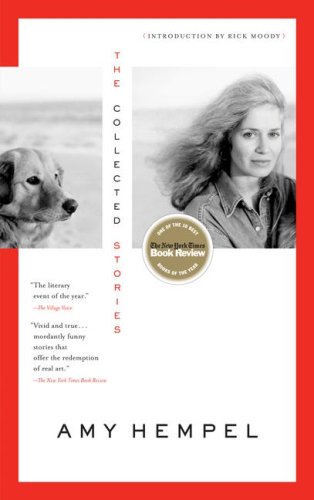“Hay momentos en que los lobos callan
y momentos en que la luna aúlla”
Amy
Hempel
"If it's true that your life flashes past your eyes before you die, then it is also the truth that your life rushes forth when you are ready to start to truly be alive."
-Amy Hempel
Amy Hempel, The Art of Fiction No. 176
by Paul Winner
Amy Hempel does not enjoy interviews. She quotes her friend Patty Marx: “I’m not good at small talk; I’m not good at big talk; and medium talk just doesn’t come up.” Talking about the self is both unseemly and unnerving, she feels, and dissecting her own deliberate process of composition through, in her words, “pointy-headed questions,” tends to provoke her exasperation. This makes for an elusive interview. However, over a humid June weekend at her home last year, Hempel behaved as a polite and gracious host who pointed out the sights and chatted about movies, politics, and theories of pet care, but nonetheless wanted very much to be doing all of it away from the tape recorder. Talking about writing, in particular, meant noticing how Hempel loves to quote, at length, those friends and writers dearest to her—and how much she prefers their words to her own.
Born in 1951, Hempel grew up in Chicago and Denver before moving at sixteen to California, the inspiration for what would eventually become the extraordinary, unreal setting for her earliest fiction. She spent time in and around San Francisco until, over a two-year span, a series of significant events unfolded: her mother took her own life, her mother’s younger sister soon followed, she was injured in two massive auto accidents, and three years later, her best friend—a young woman who became well-known through Hempel’s most anthologized story, “In the Cemetery Where Al Jolson Is Buried”—died from leukemia.
In 1975, Hempel moved to New York City, worked through a couple of publishing jobs, then located a nighttime writing class at Columbia with Gordon Lish, a writer and editor at Knopf whose demanding workshops (Tactics of Fiction) became legendary. Their classes together would mark the start of a long professional relationship, resulting in the 1985 publication of her first book, a brilliantly stylized array of short pieces entitled Reasons to Live. At a time when short stories were a publishing standard, hers were an immediate success. She wrote for Vanity Fair and The New York Times Magazine. She taught classes across the country. In 1990, Hempel brought out her second collection, At the Gates of the Animal Kingdom, which, in her words, saw her “branching out from grief to fear.” Seven years later, confirming a pattern of taking a long time to write short stories, she returned with Tumble Home, a book that put her formal considerations—the packed sentence, the mutability of voice, the suggestive and highly condensed moment—to use in the title novella, her longest work to date.
Hempel recently returned to New York City after five years in Bridgehampton, New York; at the time of this interview she was temporarily in Cold Spring, New York,
living in an isolated, modern, one-story wooden house near a lake. Around the house were photographs by William Wegman. Moving boxes. In a sunroom facing a corner was a handsome antique library table. On its surface were the following: a ceramic three-headed dog, a Southwestern lamp, a copy of the
Star (...) (
Interviewed by Paul Winner)
(http://www.theparisreview.org/interviews/227/the-art-of-fiction-no-176-amy-hempel)
 Amy Hempel nació en Chicago, Illinois. Ella es muy conocida por sus obras
de ficción y no ficción.
Amy Hempel nació en Chicago, Illinois. Ella es muy conocida por sus obras
de ficción y no ficción.
En 1985, publicó su colección de cuentos en primer lugar,
Reason to
Live , que ganó el Commonwealth Club
de California, Medalla de Plata. Amy es también el autor de En las puertas del Reino Animal y Tumble
Home , y es el co-editor de la
antología, Unleashed: Poemas de perros de
escritor .
Historias de Amy han aparecido en
la revista Vanity Fair, Harper,
The Quarterly, The Yale Review , y varias antologías,
entre ellos La Antología Norton de
Cortometraje de Ficción . También trabaja como editor
colaborador de la revista
Bomb .
Amy ha ganado varios premios
literarios de prestigio por su trabajo, incluyendo el Premio de Hobson y una
beca Guggenheim. Con los años, se ha desempeñado como juez para el National
Book Award, el premio PEN / Revson, El Premio PEN / Hemingway, y el Premio Mary
McCarthy, entre otros.
Amy también ha enseñado en varias
universidades y universidades de todo el país, incluyendo la New York
University, Universidad de Saint Mary, y la Universidad de Missouri.
Actualmente
es miembro de la facultad en los programas de posgrado de escritura de la
universidad de Bennington en Vermont y la New School University en Nueva
York.
The 100 Best Books of the Decade (From The Times)
31.- The Collected Stories of Amy Hempel (2006) Mortality haunts these extraordinary, blackly funny stories. Here 20 years’ worth of Hempel’s work is collected — four slim volumes only. She may not be a prolific author but she is a true artist of the story form.

“Here's a trick I found for how to finally
get some sleep. I sleep in my husband's bed. That way the empty bed I look at is
my own.”
(“He aquí un truco que descubrí para por fin poder dormir. Me acuesto en la cama de mi marido. De este modo, la cama vacía a la que me enfrento es la mía”.)
Amy Hempel, "Nashville Gone to Ashes." The Collected Stories.
Photo by Anne Kristoff

 Amy Hempel nació en Chicago, Illinois. Ella es muy conocida por sus obras
de ficción y no ficción.
Amy Hempel nació en Chicago, Illinois. Ella es muy conocida por sus obras
de ficción y no ficción.







No hay comentarios:
Publicar un comentario